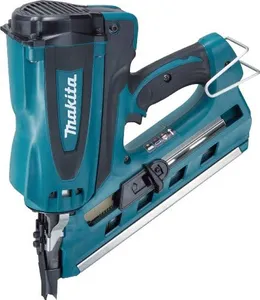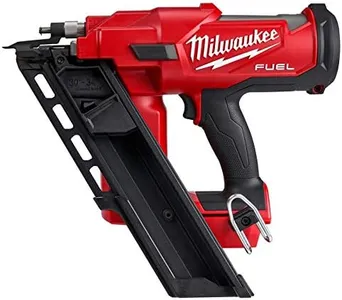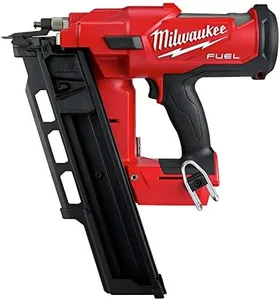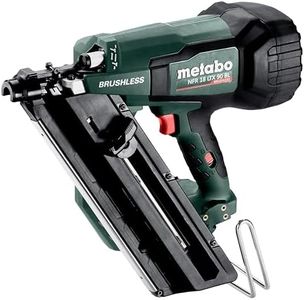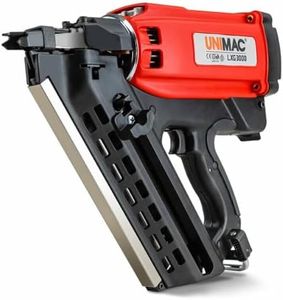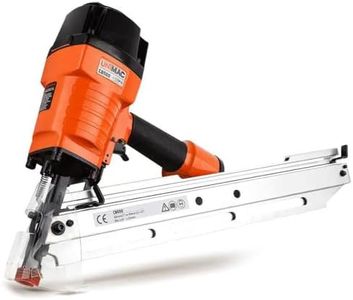We Use CookiesWe use cookies to enhance the security, performance,
functionality and for analytical and promotional activities. By continuing to browse this site you
are agreeing to our privacy policy
6 Best Cordless Framing Nailer
From leading brands and best sellers available on the web.Buying Guide for the Best Cordless Framing Nailer
Choosing a cordless framing nailer can make your woodworking or construction projects much easier and more efficient. The right model will help you work faster and with better accuracy, but there are important features to consider to ensure the tool fits your specific needs. Understanding the main specifications will help you navigate through the options and select the best tool for your type of work and comfort.Power Source (Battery Type and Voltage)Cordless framing nailers rely on batteries as their power source, which affects how long and how powerfully they work. Batteries often come in different voltages—typically ranging from 18V to 20V or higher. Higher voltage usually means more powerful driving force, which is useful for longer nails and tougher materials, but these may also make the tool heavier. If you mostly work on lighter jobs or need to handle the tool for longer periods, a moderate voltage may be comfortable, while heavy-duty users may want the extra power.
Nail Size and Type CompatibilityThis specification tells you the range of nail lengths and gauges the nailer can accept. Some nailers can shoot nails from 2 to 3.5 inches, while others might have a broader or narrower range. Consider the size and type of projects you plan to do—if you need the tool for framing, decking, or fencing, make sure it supports the nail lengths and types commonly required for those jobs. Versatility in nail size can make the tool more useful across different tasks.
Magazine CapacityThe magazine capacity indicates how many nails the tool can hold at once. Higher capacity means fewer reloads, which is crucial for efficiency on big projects. However, a larger magazine might add weight and bulk to the tool. If you work on large-scale construction projects, a higher capacity helps you work longer without interruption. For smaller jobs or occasional use, a lower capacity may be sufficient and could make the tool lighter and easier to handle.
Firing ModesFiring modes refer to how you trigger nail discharge—typically sequential (where nails are fired one at a time with each trigger pull) or bump (which allows for rapid-fire as long as the trigger and nose are pressed). Sequential is safer and better for precision, while bump mode is faster for quick framing work. Picking the right firing mode depends on your experience level and the focus of your work. If you value safety and accuracy, look for a model with reliable sequential mode. If speed is key, bump mode could be a better fit.
Weight and ErgonomicsThe weight and ergonomic design determine how comfortable the tool is during use, especially for extended periods or overhead work. Heavier nailers may cause more fatigue and be harder to control, while lighter models are friendlier for long sessions but may lack a bit in durability or power. Handling different models, if possible, helps you judge what feels best—consider your strength, how long you typically work, and whether you'll be using the tool in tight or overhead spaces.
Depth AdjustmentDepth adjustment lets you control how deep the nails are driven into the wood. This is essential for adapting to different materials and finishing requirements—some projects need nails flush with the surface, while others may require them set deeper. Make sure the nailer has an easy-to-use and reliable depth adjustment. If you switch between different woods or tasks, this feature lets you fine-tune results without extra tools.
Jam Clearing MechanismNail jams can happen, and an easy jam clearing mechanism saves time and frustration. Some models have tool-free systems for quick clearing, while others may require tools to open the magazine. If you value smooth work with minimal interruptions, look for a user-friendly jam clearing design, especially if you anticipate heavy or frequent use.
